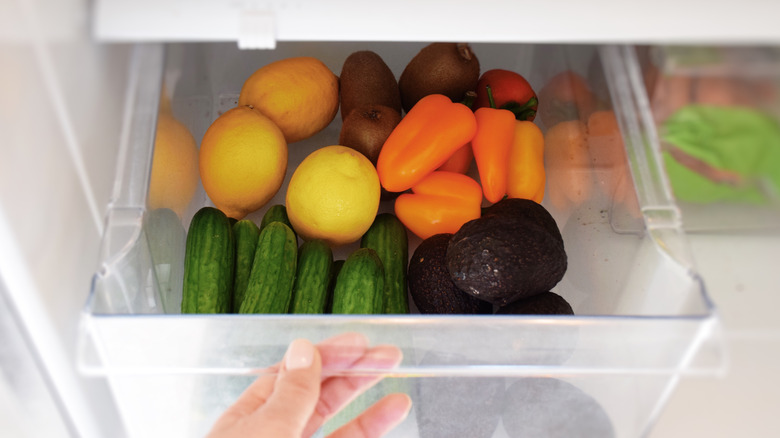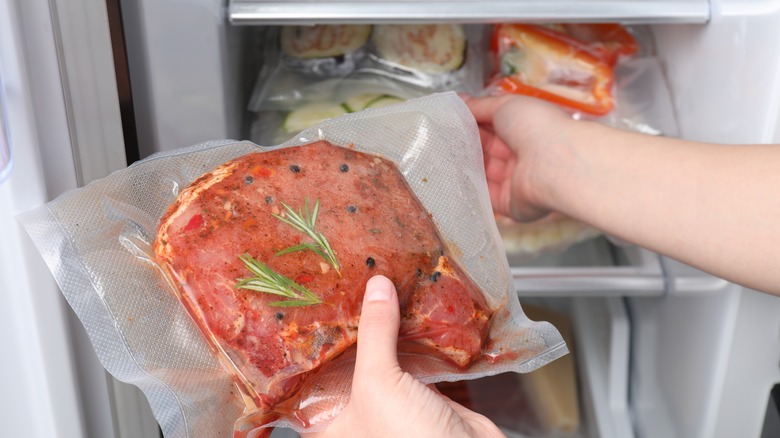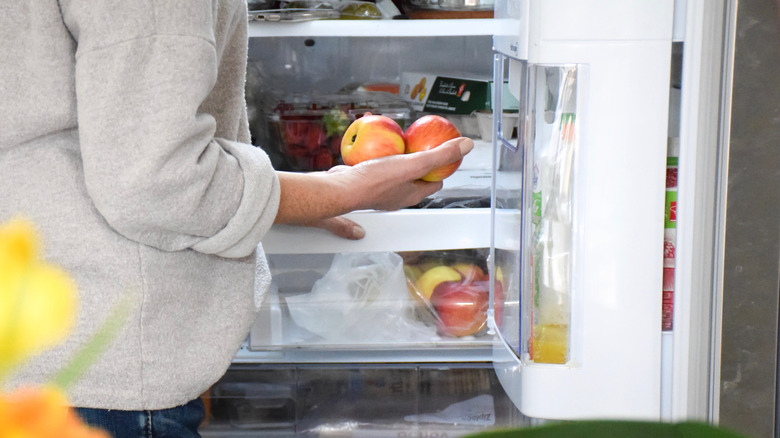How Your Crisper's Humidity Setting Could Be Sabotaging Your Produce
Ever wondered what the crisper drawers really do in your fridge? If you've already tackled how to use your refrigerator's cheese drawer, maybe it's time to get to know the compartments underneath it. To put it simply, they can help prolong the shelf life of fruits and veggies. They do this by managing the flow of air via vents that control humidity. Most crispers come equipped with a sliding lever, with settings that range from low to high humidity. At its lowest setting, the drawer's vents are completely open, giving you a non-humid environment. The highest setting, however, will completely close the vents, creating an isolated environment with more moisture.
Different items respond better to each environment, and if you notice your fruit spoiling too quickly, you may have your drawers set incorrectly. Have produce that's prone to spoiling fast? You want to avoid excessive humidity. These include fruits that are high in ethylene gas, such as apples, peppers, and peaches. By keeping the vents open, this gas is able to escape and disperse, slowing the ripening process.
Items that tend to wilt, on the other hand, should be kept in a high-humidity atmosphere. This covers leafy greens like kale or Swiss chard, salad greens like lettuce, and thin-skinned vegetables like broccoli. If you have two crispers, it's best to designate one for low moisture items, and the other for their counterparts.
Storing meat in your crisper drawer
Some refrigerators come equipped with a fresh drawer — another pull-out chamber that is usually located beneath the crisper drawers. If you have one of these, this is the best place to store raw meat, poultry, or fish. These items should always be kept at the bottom of your fridge in order to reduce the risk of cross-contamination. If you leave uncooked meat on a higher shelf, there's always the chance that its juices could drip onto other foods. The fresh drawer should be at the bottom of your fridge, which also means that it's the coldest place. This makes it ideal for meat, which will spoil quickly under imperfect conditions.
Even if you don't have a fresh drawer, you can designate one of your crisper drawers for animal products to avoid some common mistakes with raw meat. This will still create a cold environment that provides protection for the rest of your refrigerator. If you do this, just make sure you don't store anything else with the meat. Using one of the drawers for meat will also mean you need to choose one humidity setting for the single drawer that's now storing vegetables.
Getting the most out of your produce
One of the best ways to keep your crisper drawers organized is by using the restaurant storage method of "first in, first out." This involves storing food that is more likely to spoil in the front of the compartment. Items that you bought more recently, or that will take longer to go bad, should be kept in the back. For example, a head of broccoli that you bought four days ago should be placed in front of some cauliflower you bought today. That way, you're always reaching for what needs to be used up most quickly first.
Similarly, don't overcrowd your drawers, as this can cause ingredients to be smashed by other goods. Crowding also won't allow for air circulation, which can cause an increase in ethylene and thus spoilage.
In addition to separating your low- and high-moisture goods between your two crispers, some items should not be placed in either drawer at all. Some things, such as citrus, need as little moisture as possible, so they shouldn't be kept in a drawer at all. Similarly, anything that will soften or lose flavor in the refrigerator should never make it to the crisper drawer. Something like tomatoes, which need to be stored the right way (room temperature) until they ripen, should stay out.



